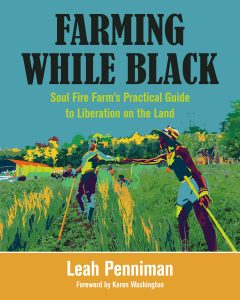 By: Terri Schlichenmeyer
By: Terri Schlichenmeyer
Your hands are filthy.
Dirt lines every crease and covers much of your knuckles. It’s beneath your fingernails, all the way up to your wrists, soiling the edges of your sweatshirt and down your front. Yes, your hands are filthy but once you’ve read “Farming While Black” by Leah Penniman, your smile will be wide.
Years ago, in search of a way to make a difference in Black lives, Leah Penniman fell in love with cilantro. She met it on the first day of an urban program to teach people to grow food, and when she smelled the herb, it was “magical.” It made her want her own farm, to feed her children, to ease the dire statistics she knew about obesity and heart disease among African Americans and Native Americans, and to lessen the terrible commonness of “food deserts.”
To begin, she says, “Aspiring farmers need three essential ingredients… training, land, and material resources.” Training can be received through classes or intern programs, but be careful what you ask for: some programs might require you to work for free, which may be “all too reminiscent of the exploitation of [your] ancestors.”
As for acquiring land, you may find what you need by “squatting” (check local laws), or by finding a farmer who’s retiring. Know your options when it comes to financing, and make a business plan; in fact, never tackle a farm without a plan.
If the land you want has been ill-cared for, don’t despair. There are ways of restoring land that has been neglected. Know what to “feed” it, and then know proper land management methods to maintain soil health. Think carefully about what you’ll plant; food and medicine may both be welcome in your community. Know the proper (and safe) way to use tools, and how to take care of those you use. Add animals to your farm. And finally, remember that you don’t have to have acres and acres to farm; a small, abandoned corner is a perfectly valid way to dip your toes in the dirt.
Although it’s a little pricey, as paperbacks go, “Farming While Black” is absolutely one of those books where you get your money’s worth.
Starting with the illustrative story of Soul Fire Farm’s beginning, author Leah Penniman offers statistics to prove on-going need, and history to show that farming isn’t anything new for Black Americans. In today’s world, though, Penniman advocates community-based farms that are tended not by one set of hands but by many – and she takes their creation step-by-step so that readers don’t feel overwhelmed. Indeed, her thoroughness here (it seems as though every little detail is covered) makes this a solid reference book for farms and community gardens of all sizes.
Be aware that this book may seem somewhat new-agey at times, and it can over-reach, too; some chapters seem superfluous. Even so, for budding farmers, new green thumbs, or aspiring back-to-the-landers, it could be the exact right book to have. For you, missing “Farming While Black” would be a dirty shame.




